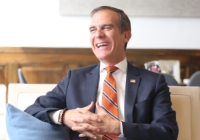THE TITLE AND THEME of this issue of Blueprint — our 15th, for those keeping score — comes from a classic work of journalism and political science, Vincent Cannato’s The Ungovernable City, which chronicles the struggles of Mayor John Lindsay to arrest the declining fortunes of New York City in the late 1960s and early 1970s. Cannato’s examination found Lindsay sorely lacking and New York spinning away from all attempts to exert control over its fate and future.
We approach California somewhat differently, beginning with the title. Note the addition of the question mark, as in: “The Ungovernable State?” It is there because, while Cannato’s verdict on New York was firm and depressing — and, arguably, incorrect, in light of New York’s later rebound to prosperity — views of California’s governability tend to waver depending upon who’s in charge.
When Arnold Schwarzenegger was governor in the 2000s, it was fashionable to suggest that California was lost. Schwarzenegger came to office amidst an energy crisis that felled Gray Davis. Faring only a little better, Schwarzenegger governed the state during a recession and more than one budget crisis, which caused some to compare California to Greece among the world’s “failed states.”
Such talk subsided after Jerry Brown returned to office for his second gubernatorial stint, beginning in 2011. Brown, who succeeded Ronald Reagan in 1975 (meaning that Brown came to office not once but twice on the heels of an actor), brought with him a commitment to frugality. Aided by a rebound in the economy and success in convincing voters to tax themselves, he restored the state’s fiscal stability. By the time he left office in 2019, there weren’t many still arguing that California was beyond governance.
Now, three years later, the state is weathering the effects of COVID and its ruinous pounding on the economy. There are clear signs of improvement — California’s job growth leads the nation, and Los Angeles’ job growth leads California. The state surplus is bigger than that of any other state — ever. But there are also deep wells of worry: rampant homelessness, staggering inequality, skyrocketing housing costs.
This seems, then, an appropriate time to plumb some of the core questions of California’s governance. Does democracy here work? The failed recall of Gov. Gavin Newsom left no one happy, but does that mean the system is broken, or just that it was tested? Is voting here fair? Are emerging communities finding their way into the political process, or are they being excluded? More concretely, is the government able to protect its people — from crime, on one hand, and from abusive policing, on the other? Is California headed in the direction of safety and harmony, or is it trending away from both?
That is what this issue of Blueprint seeks to examine. We have set out less to answer the question of California’s governability and more to raise it as a challenge to the state and its leadership. In the end, California is governed because it has to be. Whether it is governed successfully, in such a way as to protect its people from harm, shelter them and allow them to prosper — this is the challenge California needs to address.























